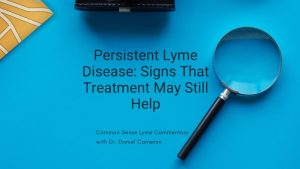Call for your appointment today 914-666-4665 | Mt. Kisco, New York

In their article, Bransfield et al. describe two patients with complex, multisystemic illnesses, which included Lyme disease. Both patients suffered from debilitating symptoms over several years, leaving them unable to walk and confined to a wheelchair. Doctors dismissed their complaints, which ranged from fatigue and weight loss to seizures and cognitive impairments. They were labeled as having “hysteria” and “wanting attention” rather than psychiatric Lyme disease.
From martial-arts athlete to wheelchair-bound
The first case involved a healthy, athletic 18-year-old female who was skilled at Taekwondo. The girl developed a bull’s-eye rash, followed by Bell’s palsy. Over a 4-year period, she became increasingly disabled and eventually required a wheelchair. She also suffered from seizures.
The girl’s symptoms included: cognitive impairments (attention, memory, processing speed, concentration/executive functioning), tactile hypersensitivity, sun sensitivity, orthostatic hypotension, weight loss, fatigue, non-restorative sleep, pelvic pain, difficulty urinating, headaches, peripheral neuropathy, muscle atrophy, cervical radiculopathy, hair loss, costochondritis, subluxation of multiple joints, and generalized pain.
Clinicians initially diagnosed her with fibromyalgia, “wanting attention,” chronic fatigue syndrome, hypoglycemia, and “pseudoseizures”, according to Bransfield rather than psychiatric Lyme disease.
However, she was eventually diagnosed with late-stage Lyme borreliosis with multisystem symptoms, along with porphyria, Ehlers-Danlos/ALPIM syndrome (anxiety-laxity-pain-immune-mood) with seizures caused by increased intracranial pressure from cranio-cervical instability, writes Bransfield.
Upon further evaluation, clinicians diagnosed the girl with complex partial seizures, rather than ‘pseudoseizures’ or psychiatric Lyme disease.
“The patient was subsequently treated,” writes Bransfield, “and is now physically active, married, and leading a productive life.”
From ‘hysteria’ diagnosis to encephalitis
A 12-year-old girl from England suffers from leg pain and is diagnosed with reactive arthritis. She is admitted to the hospital complaining of “excruciating headaches, a complete loss of balance, and involuntary jerking movements,” explains Bransfield. The girl was discharged but her symptoms worsened.
One clinician’s assessment described the girl’s condition as “Hysteria, possible conversion disorder.” The patient “was left deteriorating and untreated, by which time she was having constant seizures and needed a wheelchair,” writes Bransfield.
Unfortunately, doctors ignored repeated requests by the mother to consider psychiatric Lyme disease, as the family lived in an endemic region and other family members had been infected.
[bctt tweet=”Once diagnosed and treated for Lyme disease, 2 children confined to a wheelchair are able to walk again. ” username=”DrDanielCameron”]
The girl was moved to another clinic where she was diagnosed with “encephalitis and possible encephalomyelitis (inflammation of the brain/brainstem/spinal cord), probably due to Lyme disease,” writes Bransfield.
She immediately began IV antibiotics and within 36 hours, the girl’s seizures had stopped and her headaches began to subside. Tests for Lyme disease came back positive.
After 2 months of IV treatment, the patient was able to walk again. But once antibiotics were stopped, the symptoms returned. The girl continued treatment in the United States but reported having persistent symptoms due to a delay in treatment.
Making the diagnosis can be difficult.
“Some healthcare providers have great difficulty understanding and making an accurate diagnosis when these symptoms are present and categorize them as being ‘vague’ or ‘subjective’ symptoms and, therefore, less valid,” writes Bransfield.
Individuals can be mislabeled as hypochondriacs.
“The number and the complexity of these symptoms can be overwhelming to the patient, and the patient may be labeled as being hypochondriacal, a psychosomatic illness, or having bodily distress disorder or somatic symptom disorder,” writes Bransfield.
“Historically, there has been a tendency to label physical symptoms that could not be explained as being of a psychiatric origin,” writes Brasfield.
“As a result, many patients with complex, confusing symptoms and poorly understood diseases who receive an inadequate assessment for their condition are often referred to psychiatrists until the time when the disease is better understood and defined.”writes Bransfield.
Related Articles:
Seizures and altered mental status after a tick bite
Dismissing chronic Lyme disease for somatic symptom disorder diagnosis
Yale doctor says children don’t have Lyme but medically unexplained symptoms
References:
- Bransfield RC, Friedman KJ. Differentiating Psychosomatic, Somatopsychic, Multisystem Illnesses and Medical Uncertainty. Healthcare 2019, 7, 114.




I have had Lyme symptoms for three years. Weight loss, hair loss, headaches, stiff neck, early wakening, eye twitches, tested high level of mold toxicity. I also lost sense of taste and smell. Have had burning in my back and head almost constantly. Currently seeing a functional medicine doctor. Getting a little better but would love to wake up without a headache everyday. Also have had chronic sinus infection.
What do the doctors say about your symptoms?
Have you been diagnosed with Lyme disease? I ask because you just listed all of my symptoms. I did not realize these symptoms were related to Lyme disease. I just feel like I am going crazy.
This just demonstrates the degree of denial of basic Science common sense … as regards the myriad pathogens found within ticks and other vectors!
This denial is much more puzzling than the riddle of the Sphinx! It’s high time Lyme and it’s cousins be recognized as the life destroying entities they are. Wake up, medical schools and institutions! Please!
Late stage Lyme yet I keep getting psychiatric diagnoses, wish they would wake up I have late stage Bartenella Babasia mymotio and hell more i lived in Connecticut in the 70 s and sure that’s where I started yet have been bitten many times when I think about it. I wish that medical system we have would learn about Lyme . I know more than they do , that’s scary as hell